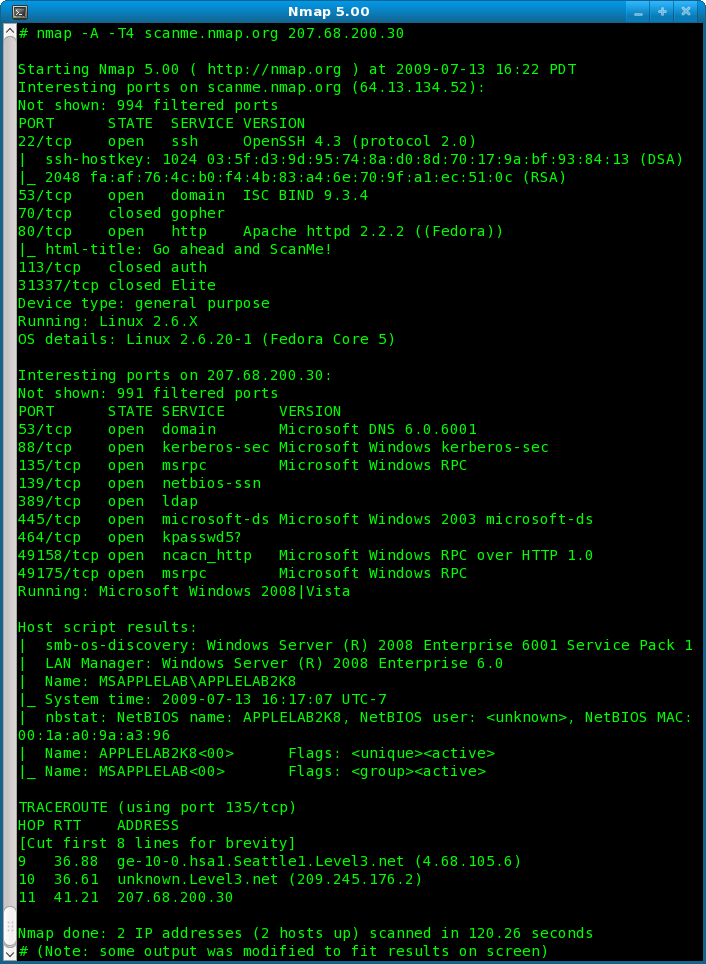

- #Nmap command line for mac install
- #Nmap command line for mac software
- #Nmap command line for mac series
Networking: Must-read coverageīest network monitoring software and tools 2022ĥ programming languages network architects should learn (free PDF)īehind the scenes: A day in the life of a database administratorģ essential productivity-boosting resources for network admins (TechRepublic Premium) Fortunately, there are some very simple-to-use command line tools that can handle this task. But what if you’re on a GUI-less server? You certainly won’t rely on a graphical-based tool for scanning IP addresses.
#Nmap command line for mac install
Nmap adds a versatile tool to any system administrator’s arsenal for debugging and locating security flaws.How many times have you tried to configure a static IP address for a machine on your network, only to realize you had no idea what addresses were already taken? If you happen to work with a desktop machine, you could always install a tool like Wireshark to find out what addresses were in use. You should now understand how ports work, and why it is important to know how they are used. This guide provided an overview of Nmap scanning and how you can use it for testing ports in Linux. Most ports under 1000 are dedicated and assigned to a specific service. If a service is running on a non-default port, it might be by design – or it might suggest there is a security breach. The OS and Service scanning options are helpful for scanning a particular port or service to get more information.

This means there is something strange going on, and should be investigated. For example, you may see a service running on an unusual port number. It is possible that during your scan, you may find unusual activity. It is also considered a bad practice to tie up a server’s resources by using Nmap to run repeated scans on the same target. Often, port-scanning is seen as an aggressive method, or a prelude to a cyber attack. You should only use Nmap port scanning on servers that you own, or that you have permission to scan. Use a firewall in conjunction with other network security tools and software to scan traffic on a particular port, and to watch for suspicious traffic. You can use firewall rules to allow some ports, but block others. Here is a brief list of standard ports and their designations:Ī Linux firewall can be configured to block all traffic on a particular port.įor example, a firewall can be set to block Port 80, but users won’t be able to load any website in that case. The more intense the testing, the longer the scan will take. Replace the number 2 with a number from 0 (light testing) to 9 (run all probes). Use the ––version-intensity 2 option to specify the level of testing. Note: The –sV option can be tuned to be more or less aggressive in its scan. It can also be used to probe for the services that might be using different ports: nmap –sV 192.168.0.1 The nmap utility can be used to detect the operating system of a particular target: nmap –A 192.168.0.1 This option forces the test without waiting for a reply that may not be coming): nmap –Pn –F 192.168.0.1

(Host discovery uses ping, but many server firewalls do not respond to ping requests. Run a fast scan on the target system, but bypass host discovery. To instruct Nmap to scan UDP ports instead of TCP ports (the –p switch specifies ports 80, 130, and 255 in this example): nmap –sU –p 80,130,255 192.168.0.1 To perform the default SYN scan (it tests by performing only half of the TCP handshake): nmap –sS 192.168.0.1 To scan using TCP connect (it takes longer, but is more likely to connect): nmap –sT 192.168.0.1 To scan all ports (1 – 65535): nmap –p– 192.168.0.1 Other Types of Nmap Port Scansĭifferent types of scans can be performed: Scan (Fast) the most common ports: nmap –F 192.168.0.1 Scan ports 1 through 200 on the target system: nmap –p 1-200 192.168.0.1 Scan port 80 on the target system: nmap –p 80 192.168.0.1
#Nmap command line for mac series
Nmap commands can be used to scan a single port or a series of ports: You can use this to test your Nmap utility. Note: The developers at provide a test server that you can experiment on, located at.


 0 kommentar(er)
0 kommentar(er)
